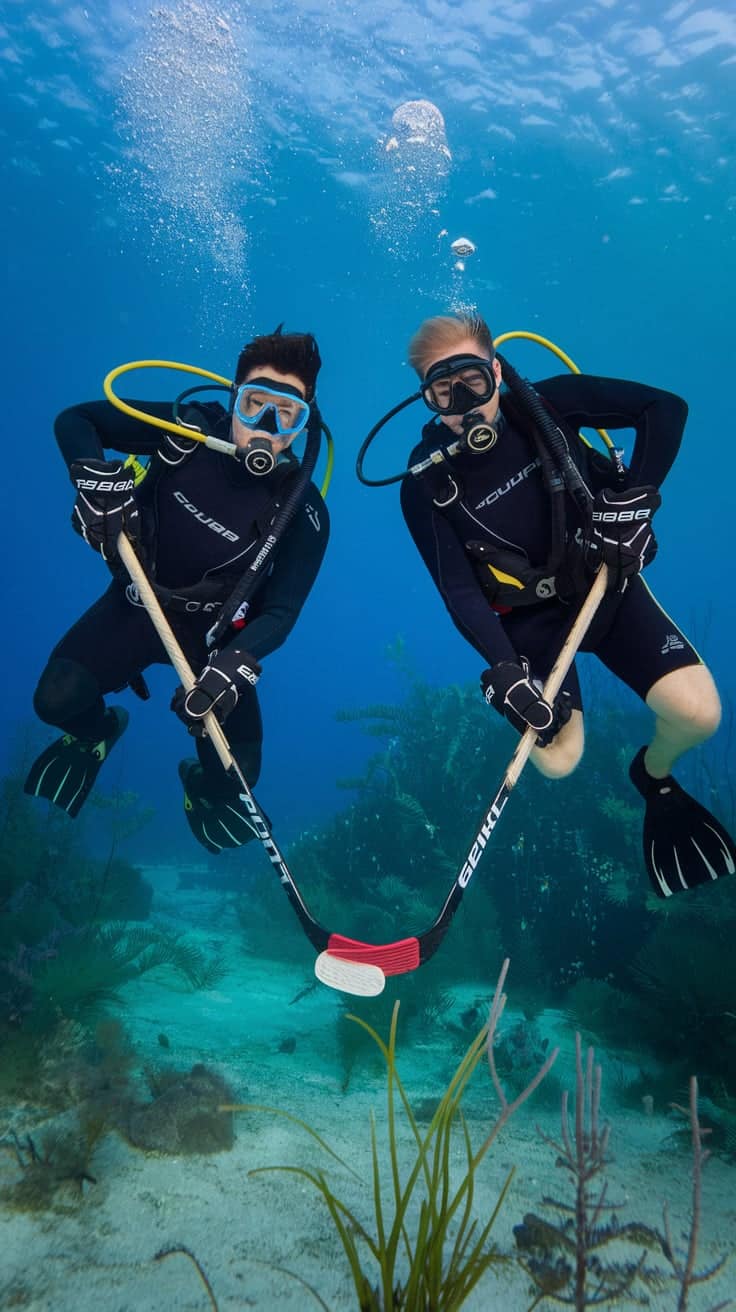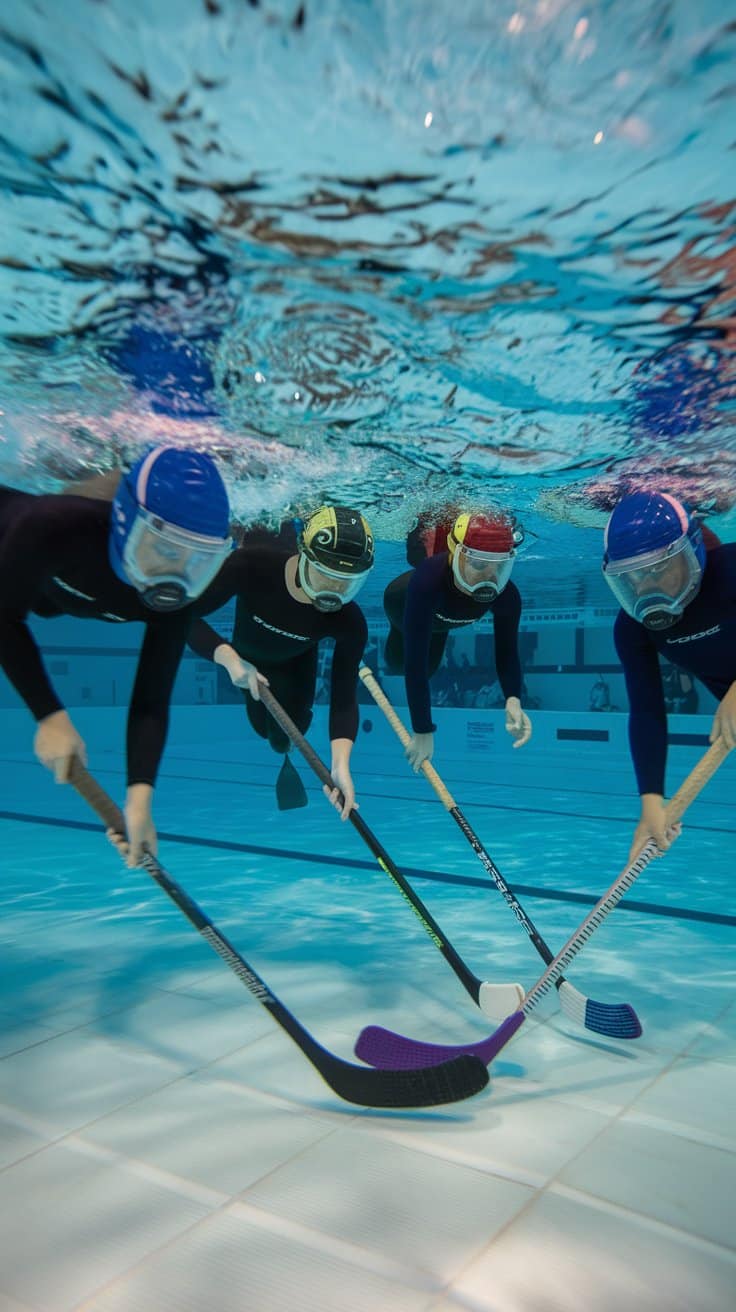Underwater hockey has a simple objective—score more goals than the opposing team by pushing a weighted puck into their goal. The game is played at the bottom of a swimming pool with six players per team. There are no goalkeepers, and players must hold their breath while making strategic moves.
As someone deeply passionate about unique sports, I find underwater hockey fascinating. It combines speed, teamwork, and endurance, making it one of the most intense and thrilling sports in the world. If you’ve never heard of it before, you’re in for a surprise!
Key Rules of Underwater Hockey
Understanding the rules is essential for playing and enjoying the game. Let’s break them down:
| Aspect | Rule |
|---|---|
| Team Size | 6 players per team, with up to 4 substitutes |
| Game Duration | Two 15-minute halves with a 3-minute break |
| Pool Depth | Usually 6-8 feet deep |
| Equipment | Stick, mask, snorkel, fins, gloves, mouthguard, and puck |
| Objective | Push the puck into the opponent’s goal using the stick |
| Penalties | Fouls result in free pucks, penalties, or player ejections |
How Does the Game Start?
At the beginning of the match, both teams line up at their respective goal lines. When the referee signals, players sprint to the center of the pool to gain possession of the puck. The challenge is that they must hold their breath while making fast-paced movements!
Scoring in Underwater Hockey
A goal is scored when a player successfully pushes or flicks the puck into the opposing team’s goal trough, which is located on the pool floor. Each goal counts as one point. The team with the most goals at the end of the game wins.
Read Must: Dive Into the Action: How Is Underwater Hockey Played?
Essential Game Strategies
Unlike traditional hockey, players cannot rely on voice communication. Here’s how teams strategize:
- Hand Signals: Since verbal communication isn’t possible, players use hand signals and eye contact to coordinate.
- Puck Flicking: Players use a wrist-flicking technique to move the puck over opponents.
- Breath Control: Most players hold their breath for 20-30 seconds before resurfacing for air.
- Positioning: Staying in the right formation reduces fatigue and improves gameplay.
Common Fouls and Penalties
Like any competitive sport, underwater hockey has strict rules to ensure fair play. Here are some common fouls:
| Foul Type | Description | Consequence |
| Stick Fouling | Hitting an opponent’s stick illegally | Free puck for opposing team |
| Obstruction | Blocking an opponent without playing the puck | Warning or penalty |
| Dangerous Play | Excessive force leading to injury | Ejection from the game |
| Holding the Pool Wall | Using walls for an advantage | Free puck to opponents |
Expert Opinions on Underwater Hockey Rules
Mark Langley, a world champion in underwater hockey, once said, “This sport is all about teamwork and technique. Following the rules is key to ensuring fair competition and keeping the game safe.”
Growing Popularity of Underwater Hockey
Did you know that underwater hockey is played in over 40 countries? The World Underwater Federation (CMAS) estimates that there are over 15,000 active players worldwide!
| Country | No. of Players |
| United Kingdom | 3,000+ |
| Australia | 2,500+ |
| Canada | 2,000+ |
| USA | 1,800+ |
| France | 1,500+ |
Additional Rules and Regulations
Substitutions and Player Rotation
Since players need to resurface for air frequently, underwater hockey allows rolling substitutions. Teams can swap out players at any time, ensuring that fresh players are always in the game.
Equipment Regulations
All players must use regulation sticks, gloves, and protective gear. Sticks are usually 10-14 inches long and made of wood or plastic. The puck, made of lead or brass, weighs between 1.3-1.5 kg and must be coated with plastic to prevent damage to the pool.
Read: Essential Gear for Underwater Hockey: Mask, Fins, Stick
Referees and Decision-Making
Underwater hockey matches have three referees—two in the water and one on the pool deck. The in-water referees closely monitor gameplay, while the surface referee oversees timekeeping and penalties.
Team Formations and Roles
A strong team formation can make or break a match. Most teams use:
- Forwards: Attackers who drive the puck forward and score goals.
- Midfielders: Versatile players who support both offense and defense.
- Defenders: Players who protect the goal and disrupt opposing attacks.
Frequently Asked Questions (FAQs)
1. Can Anyone Play Underwater Hockey?
Yes! This sport is open to people of all skill levels. Most clubs offer beginner lessons.
2. How Do Players Communicate Underwater?
They use hand signals, gestures, and eye contact to coordinate plays.
3. How Long Can Players Stay Underwater?
Most players hold their breath for 20-30 seconds before surfacing.
4. Is Underwater Hockey a Dangerous Sport?
Not really. It’s a contact sport, but injuries are rare due to strict rules and protective gear.
5. Is Underwater Hockey an Olympic Sport?
Not yet, but there are ongoing efforts to include it in future Olympic Games.
The Future of Underwater Hockey
Underwater hockey continues to grow worldwide. With increasing participation, international tournaments, and rising awareness, many believe it could become an Olympic sport in the future.
If you’re looking for a sport that challenges both your body and mind, underwater hockey is worth trying. The next time you’re at a pool, why not grab a stick, take a deep breath, and dive in?
Also read: Suit Up: The Ultimate Guide to What to Wear for Underwater Hockey
Conclusion
Underwater hockey is a one-of-a-kind sport that requires endurance, teamwork, and quick thinking. By following the rules, mastering key strategies, and improving breath control, players can enjoy this thrilling game to the fullest. Whether you’re a beginner or an experienced athlete, underwater hockey offers a unique experience that’s unlike any other sport. So, are you ready to take the plunge?



